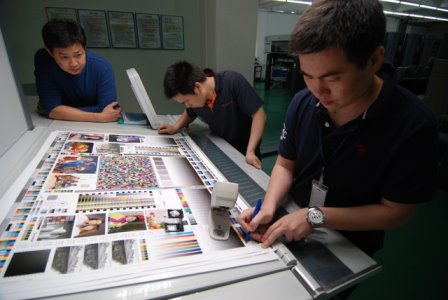
What is G7 and what does it mean to you?
IIDEAlliance's G7 is a revolutionary new methodology for calibrating proof-to-press and press-to-press across any printing method. Developed by our industry's leading color experts, the G7 methodology includes revolutionary techniques for dramatically improving print quality and consistency. As G7 'Experts', we can provide step-by-step training within your company to calibrate proofing and printing systems using the latest G7 methodology. G7 methods have been adopted worldwide: files and proofs created anywhere in the world using the G7 methods, can be matched in any pressroom. For your business, this means improved color fidelity, press sheets that match the proof resulting in quicker make-readies, faster time-to-market, and lower manufacturing costs. Take the first simple steps toward better printing: contact us at Cathay America: jpasky@gmail.com
G7 on a Post-it Note
1. Use good paper and good ink.
3. Include color bars with solids, overprints, a 50%C 40%M 40%Y neutral and a 50% or 53% midtone K patch.
4. Run to industry-standard solid ink densities.
5. Mid-tone density must be 0.54 plus the density of the paper.
6. 50%C 40%M 40%Y neutral must be exactly the same color and value as the mid-tone K.
Thursday, November 13, 2008
ISO Standard Ink Colorants
One thing I hear quite often is that, "we can't follow standards in China because our inks are different." Frankly, I haven't noticed this at all. Process inks that I've seen at the printers I visit are pretty run-of-the-mill colorants; nothing special. Measuring these process colors on many of the test forms that are piled on the floor of my office, confirms this.
Today I was cleaning out files, when I came across a swatch book from an ink maker I've never heard of before. I recall picking it up at one of the trade shows a couple of years ago. The process colors didn't look quite right, so just for fun I measured them against the ISO standard.
I was surprised that the process colors were indeed within the ISO tolerance which allows a delta E of 5.0. (ok, I must confess I had to 'cheat' a little bit on the cyan, but here are the numbers):
The magenta ink was called Rhodamine Red:
48.9 77.8 -11.9
...which measured a delta E of 4.07
The yellow:
87.6 -1.2 110.8
...for a delta E of 4.72.
That b* reading is pretty high when compared to the ISO target value of 88.2, but according to the new G7 guidance, the b* value of yellow ink is more sensitive to IFT variation than the L*. It appears that if the IFT on the color swatch was run a lighter, we could anticipate a new b* reading closer to 100 and would have resulted in a delta E value of 3.2 or less. If it were 90, the dE could have been 2.5 or less.
Cyan:
48.4 -35.0 51.4
This reading results in a delta E of 9.03. Is quite high and, at first glance, would appear to be unacceptable. But, looking more closely at the L* value and the swatch itself, it's clear that the IFT of the cyan ink swatch was run much too heavy. If by running less ink, we were to increase the L* value so it was closer to the ISO target value of L*= 57.3, the delta E would have been closer to 2.50.
I guess my point is that, this process ink-set made by 'Top Star' Ink Company is not as 'off target' as it first might appear looking at their swatch book; they just didn't do a good job of printing the swatches. (Laying down more ink to get more 'color' is not always better.) Right out-of-the-can, the ink looks like it would be passable as an ISO-compliant ink for G7 calibration purposes if the inks were run at the correct IFT. Once gray balance and tone reproduction is adjusted, the slight difference in the color of the process inks from ISO standards would be inconsequential.
This was just a quick look at one old swatch book from an unknown ink company, but the ink colorants were close enough to ISO standard tolerance to be successfully used for G7. I still haven't been convinced of the argument: "...we can't print to standard here in China...we have too many different inks..."






5 comments:
nice blog !! thanks for sharing the information about iso consultants. this blog is really nice and interested to read.
It is very nice topic and great to share informative.ISO 22000 Lead Auditor Training
Great blog! Clear, informative, and engaging—I really enjoyed reading it. Keep up the awesome work! ISO 42001 awareness training
Love how this post breaks down the importance of ISO 14001 EMS Awareness Training . It’s not just about compliance—it's about creating a sustainable future for all. 🌱
Thanks for sharing! Another great way to enhance your career is by pursuing ISO 9001 Lead Auditor Training, which can open up various auditing roles in quality management
Post a Comment